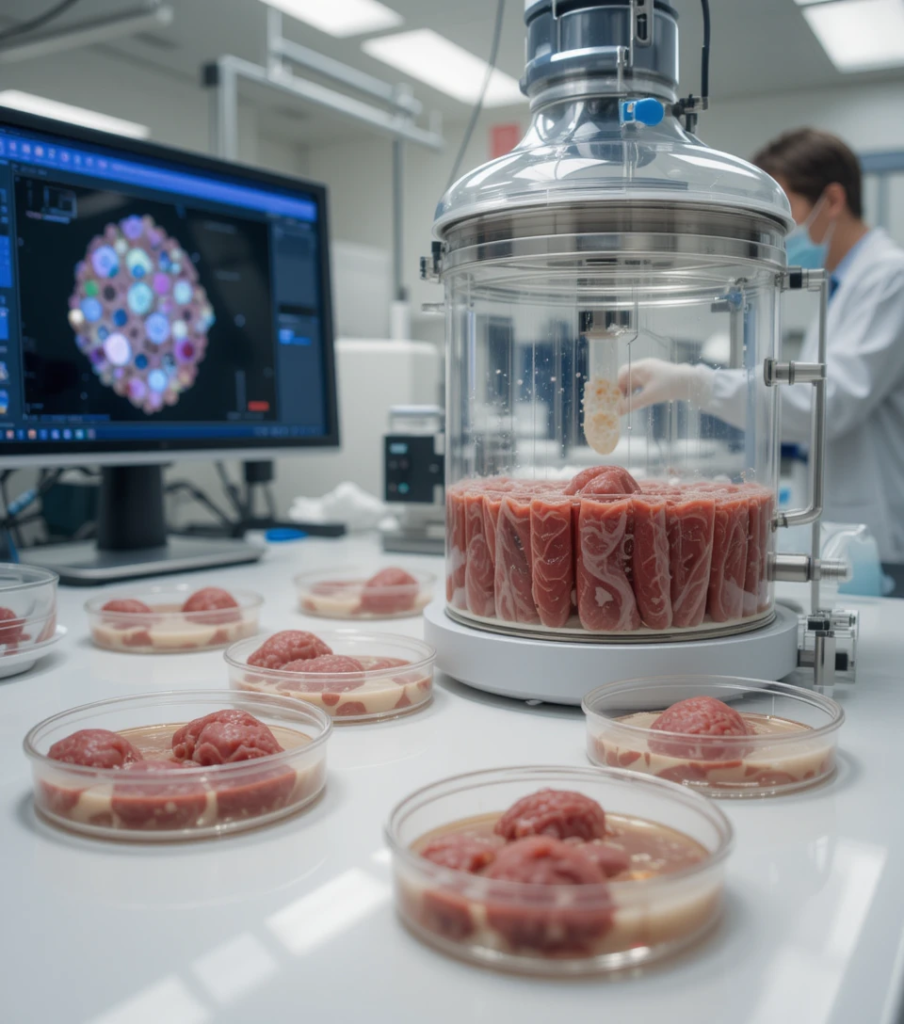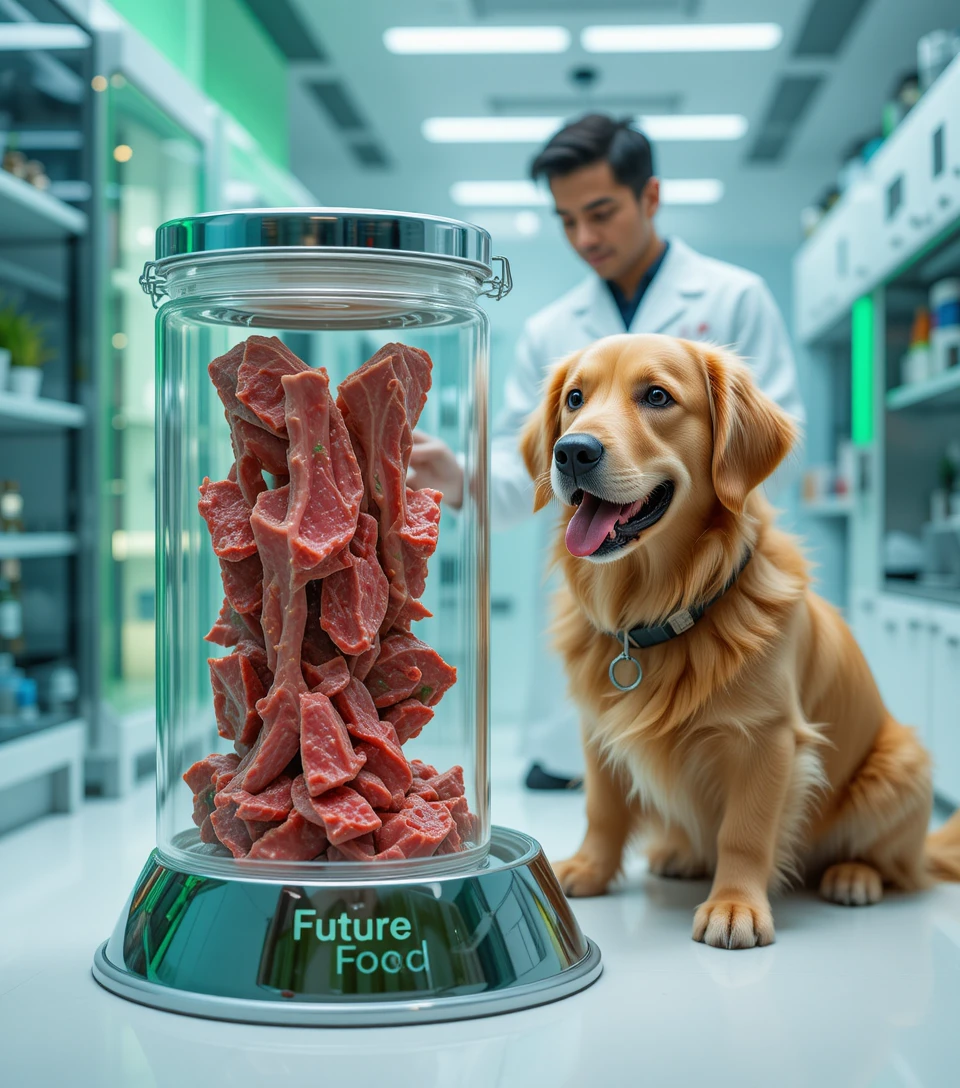Introduction
Lab-grown meat isn’t just a buzzword in human nutrition anymore—it’s now making waves in the world of pet food. Imagine feeding your dog meat that didn’t come from a slaughtered animal, yet still provides real protein. Sounds futuristic? It’s happening right now. But is this innovation safe, healthy, and truly better for your dog?
In this eye-opening article, we reveal the shocking truth about lab-grown meat in dog food, separating fact from fiction, and helping you make the best decision for your beloved companion.
1. What Is Lab-Grown Meat?

Lab-grown meat—also called cultured, clean, or cell-based meat—is produced by growing animal cells in a lab rather than raising and slaughtering animals. The process involves collecting a small cell sample from a live animal and cultivating it with nutrients and growth factors in a bioreactor. Over time, these cells multiply and form edible muscle tissue that mimics traditional meat.
Although it sounds like science fiction, this technology is already being developed for pet food by pioneering companies like Bond Pet Foods and Wild Earth.
2. Why It’s Entering the Pet Food Market
The pet food industry is under pressure to reduce its environmental footprint. Dogs and cats in the U.S. alone consume over 25% of all animal-derived calories, contributing to factory farming, deforestation, and greenhouse gas emissions.
Lab-grown meat offers a sustainable alternative:
- No animal slaughter
- Lower carbon emissions
- Reduced land and water use
Biotech startups and pet food innovators believe this approach will appeal to eco-conscious and ethically minded pet parents.
3. Is It Safe for Dogs?
This is the big question, and rightfully so. Early studies and lab trials suggest that lab-grown meat is biologically equivalent to conventional meat in terms of protein and amino acid composition.
In the U.S., the FDA and AAFCO have begun reviewing guidelines for using cell-based ingredients in pet food. Some products are already in limited release, pending further safety evaluations.
What Experts Say:
- Veterinarians stress the importance of a complete and balanced diet, whether using traditional or novel ingredients.
- Early research shows lab-grown meat poses no immediate health risks, but long-term effects are still being monitored.
4. Nutritional Comparison: Lab-Grown vs Traditional Meat

Here’s how lab-grown meat compares to conventional meat in a dog’s diet:
| Nutrient | Traditional Meat | Lab-Grown Meat |
|---|---|---|
| Protein | ✅ Complete | ✅ Complete |
| Fat | Varies | Adjustable |
| Amino Acids | ✅ Present | ✅ Engineered |
| Digestibility | ✅ High | ✅ High |
Bonus: Lab-grown meat can be tailored to include beneficial nutrients or reduce unwanted fats, which could help dogs with allergies or obesity.
5. Ethical and Environmental Benefits
Perhaps the biggest advantage of lab-grown meat is what it doesn’t require:
- No animal suffering
- No antibiotics or hormones
- No deforestation for grazing land
This ethical approach appeals to vegans, vegetarians, and environmentally conscious dog owners who want to reduce their pet’s ecological pawprint.
6. Controversies and Public Concerns
Despite the promise, lab-grown meat isn’t without controversy.
Common concerns include:
- “It’s not natural.”
- “Is it really meat?”
- “What about long-term health effects?”
Some consumers feel wary about feeding their dogs something made in a lab, despite the scientific evidence backing its safety and nutritional value.
Transparency, labeling, and education will be key to wider acceptance.
7. Vet Opinions & Early Consumer Experiences
Veterinarians remain cautiously optimistic. Many agree that if lab-grown meat meets all nutritional standards and safety checks, it could be a powerful option in pet nutrition.
Early adopters who have tried products containing lab-grown ingredients report:
- Good digestibility
- High palatability
- No allergic reactions
Still, many are waiting for more data and official guidelines.
8. Future of Lab-Grown Meat in Dog Food
In 2025, lab-grown pet food remains niche but is expanding quickly. As production costs fall and public trust grows, expect to see more commercial dog food brands launching lines with clean meat.
Future trends may include:
- Custom nutrient profiles
- Prescription lab-grown diets
- Zero-waste dog food packaging
If trends continue, lab-grown meat may move from novelty to norm within the decade.
Conclusion
Lab-grown meat in dog food is more than a passing trend—it’s a bold innovation that challenges the way we feed our pets. It offers exciting benefits: sustainability, ethics, and customizable nutrition. Yet, questions remain around long-term safety, regulation, and public acceptance.
As research grows and more brands join the movement, dog owners have a unique opportunity to explore this cleaner, greener path. The truth may be shocking—but it could also be the future.
🐶 10 Frequently Asked Questions
1. Is lab-grown meat safe for dogs to eat?
Yes, early studies suggest it’s safe and nutritionally equivalent to regular meat, but long-term data is still emerging.
2. Has the FDA approved lab-grown meat for pet food?
The FDA is in the early stages of regulating it. Some brands have received limited clearance for use in pet food trials.
3. How is lab-grown meat made for dogs?
It’s created from cultured animal cells grown in a nutrient-rich solution, forming real muscle tissue without killing animals.
4. Is lab-grown meat more nutritious than regular meat?
It can be tailored for optimal nutrition, potentially making it healthier than some conventional meats.
5. Are there any long-term effects of feeding it to dogs?
Currently unknown. Early results are promising, but more long-term studies are needed.
6. Why would I choose lab-grown meat over traditional dog food?
For ethical, environmental, or allergy-related reasons. It’s cruelty-free and may reduce your pet’s carbon pawprint.
7. Do dogs like the taste of lab-grown meat?
Yes! Early tests show high palatability and acceptance by dogs.
8. Is lab-grown meat vegan or cruelty-free?
It’s cruelty-free but not vegan, as it originates from animal cells. However, no animals are killed in the process.
9. How much does it cost compared to regular dog food?
Currently more expensive, but prices are expected to drop as production scales.
10. Which dog food brands use lab-grown meat in 2025?
Brands like Bond Pet Foods and Wild Earth are early adopters in the space.

